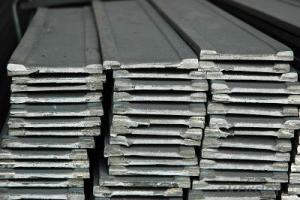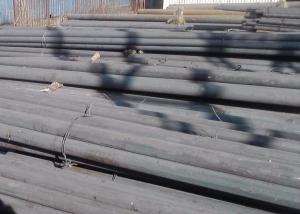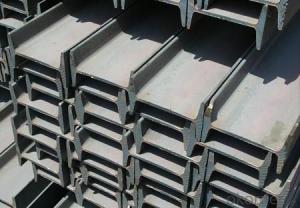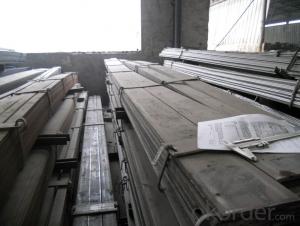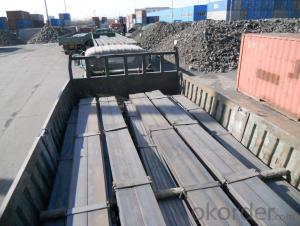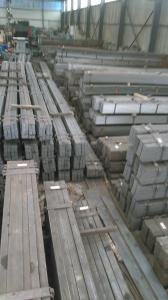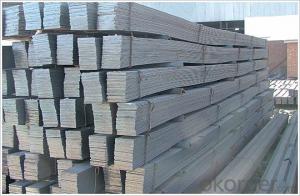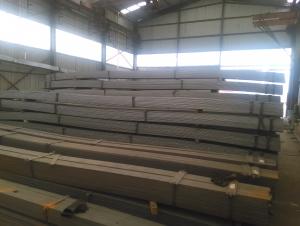JIS standard steel flat bar for construction
- Loading Port:
- Tianjin
- Payment Terms:
- TT OR LC
- Min Order Qty:
- 10000 m.t.
- Supply Capability:
- 100000 m.t./month
OKorder Service Pledge
OKorder Financial Service
You Might Also Like
Item specifice
Product Description:
OKorder is offering JIS standard steel flat bar for construction at great prices with worldwide shipping. Our supplier is a world-class manufacturer of steel, with our products utilized the world over. OKorder annually supplies products to European, North American and Asian markets. We provide quotations within 24 hours of receiving an inquiry and guarantee competitive prices.
Product Applications:
JIS standard steel flat bar for construction are ideal for structural applications and are widely used in the construction of buildings and bridges, and the manufacturing, petrochemical, and transportation industries.
Product Advantages:
OKorder's Steel flat bar are durable, strong, and resist corrosion.
Main Product Features:
· Premium quality
· Prompt delivery & seaworthy packing (30 days after receiving deposit)
· Corrosion resistance
· Can be recycled and reused
· Mill test certification
· Professional Service
· Competitive pricing
Product Specifications:
Manufacture: slited
Slitting precision (width) : 0.5 mm or less
Raw material: Q235B, Q345B, Q235-1 b
crosscutting precision (length) : 2 mm or less
Processing: the thickness of 2.0-16 mm;
Shear length: 2000 mm above
Wide degree: 15-1250 - mm;
Leveling precision: 1-2 MM square
Packaging: Export packing, nude packing, bundled
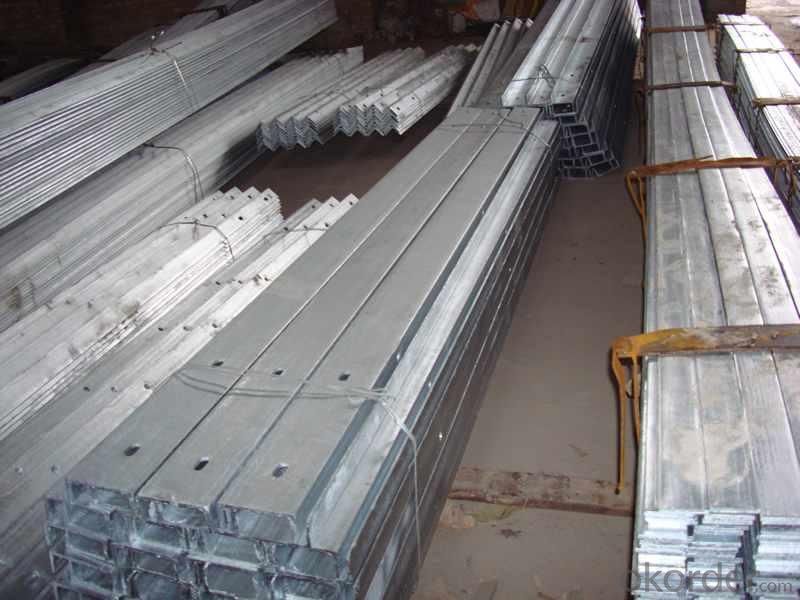
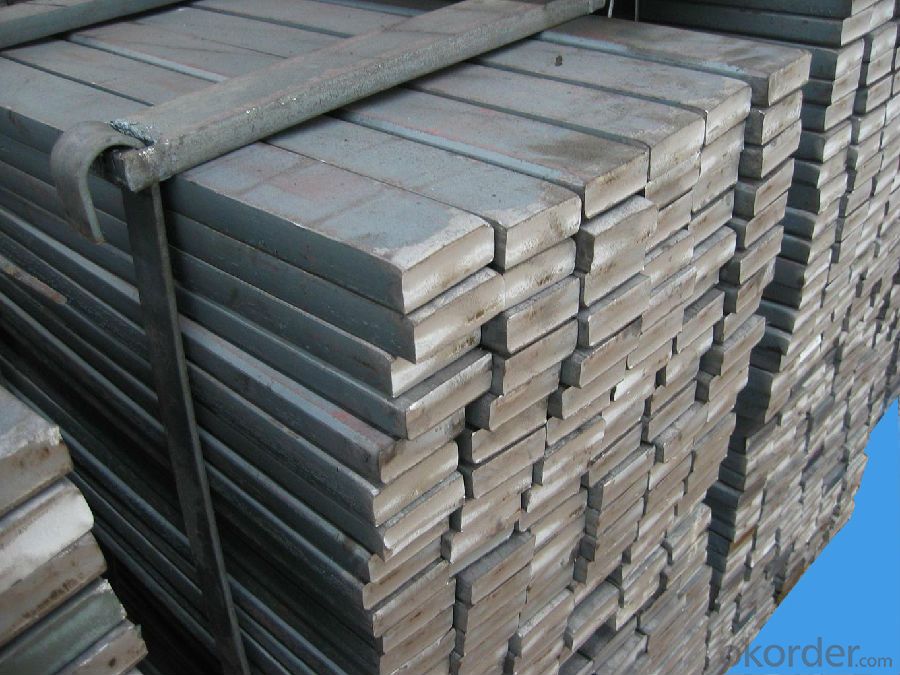

FAQ:
Q1: What makes stainless steel stainless?
A1: Stainless steel must contain at least 10.5 % chromium. It is this element that reacts with the oxygen in the air to form a complex chrome-oxide surface layer that is invisible but strong enough to prevent further oxygen from "staining" (rusting) the surface. Higher levels of chromium and the addition of other alloying elements such as nickel and molybdenum enhance this surface layer and improve the corrosion resistance of the stainless material.
Q2: Can stainless steel rust?
A2: Stainless does not "rust" as you think of regular steel rusting with a red oxide on the surface that flakes off. If you see red rust it is probably due to some iron particles that have contaminated the surface of the stainless steel and it is these iron particles that are rusting. Look at the source of the rusting and see if you can remove it from the surface.
- Q:Do steel flat bars have rounded edges or sharp edges?
- Steel flat bars can have either rounded edges or sharp edges, depending on how they were manufactured or processed. Some steel flat bars are produced with rounded edges, which are often referred to as "round edge" or "radius edge" bars. These rounded edges provide a smoother and safer surface, reducing the risk of injury from sharp edges. On the other hand, some steel flat bars may have sharp edges, especially if they were cut or sheared from larger pieces of steel. These sharp edges can be more prone to causing injuries if not handled carefully. Therefore, it is important to check the specific product description or inquire with the manufacturer or supplier to determine whether the steel flat bars have rounded or sharp edges.
- Q:Can steel flat bars be bent without breaking?
- Steel flat bars can indeed be bent without breaking. However, the ability of steel to withstand bending without breaking depends on several factors, including the thickness and grade of the steel, as well as the bending technique employed. Commonly, steel flat bars are bent using either cold bending or hot bending methods. Cold bending is typically employed for thin and malleable steel bars and is performed at room temperature. On the other hand, hot bending may be necessary for thicker or harder steel bars. This technique involves heating the steel to a high temperature and bending it while it is still hot. By carefully controlling the bending process and ensuring that the steel does not surpass its elastic limit, it becomes possible to bend steel flat bars without causing them to fracture.
- Q:Do lightning protection, lead out of the galvanized round steel, flat steel needs to be inspected?
- The corrosion resistance of cold galvanizing is not as good as that of hot-dip galvanizing. It is used as lightning protection and grounding material. It is corroded quickly, and the grounding resistance is raised rapidly. It exceeds the required resistance.
- Q:How many years can hot dip galvanized flat steel be used?
- Coastal areas usually refer to a region within a mile of the sea. The ocean atmosphere can spread deeper inland, especially on islands. The prevailing winds come from the ocean, and the climate is bad. If the wind is mixed with ocean fog, especially due to evaporation and accumulation of salt deposits, coupled with less rain and less frequent rain erosion, coastal conditions will be even more unfavourable. If there is any industrial pollution, there is more corrosive. Hot galvanized flat steel in such circumstances, usually 20 years or so.
- Q:What are the different methods of surface patterning for steel flat bars?
- There are several different methods of surface patterning for steel flat bars, each offering unique benefits and characteristics. 1. Hot Rolling: This method involves passing the steel flat bar through a series of heated rollers, which creates a uniform surface pattern. Hot rolling can produce patterns such as diamond, tear, or checker plate, providing enhanced grip and aesthetic appeal. 2. Cold Rolling: Similar to hot rolling, cold rolling involves passing the steel flat bar through a set of rollers. However, this process is performed at room temperature, resulting in a smoother and more refined surface pattern. Cold rolling is commonly used to create patterns like smooth or brushed finishes. 3. Embossing: Embossing is a technique that uses high pressure to imprint a pattern onto the surface of the steel flat bar. This method allows for the creation of intricate designs and textures, making it ideal for decorative purposes. 4. Sandblasting: Sandblasting involves blasting fine particles of sand or other abrasive materials onto the surface of the steel flat bar. This process creates a rough and textured finish, commonly used to enhance grip or create a unique aesthetic appearance. 5. Acid Etching: Acid etching is a chemical process that involves applying an acid solution to the surface of the steel flat bar. The acid selectively removes the top layer of the metal, creating a pattern or design. Acid etching is commonly used to create intricate and detailed patterns on the surface of the steel. 6. Laser Cutting: Laser cutting uses a high-powered laser beam to cut or engrave patterns onto the surface of the steel flat bar. This method provides precise and accurate results, allowing for the creation of complex designs and patterns. 7. Powder Coating: Powder coating involves applying a dry powder onto the surface of the steel flat bar and then heating it to form a protective and decorative coating. This method allows for the application of various colors and finishes, providing both aesthetic appeal and corrosion resistance. Overall, the different methods of surface patterning for steel flat bars offer a wide range of options for enhancing grip, improving aesthetics, and providing protection against corrosion. The choice of method depends on the desired pattern, functionality, and intended application of the steel flat bar.
- Q:What are the different international standards for steel flat bars?
- Steel flat bars are subject to various international standards that guarantee their quality and specifications. Some commonly followed standards are as follows: 1. ASTM International (American Society for Testing and Materials): A widely used standard is ASTM A36/A36M, which specifies the requirements for steel flat bars made from carbon structural steel. It covers dimensions, tolerances, chemical composition, mechanical properties, and other relevant aspects. 2. European Norm (EN): The EN 10058 standard is applicable to hot-rolled flat steel bars with a width of 15 mm and above, and a thickness of 1 mm and above. It specifies the tolerances, dimensions, and technical delivery conditions for these bars. 3. Japanese Industrial Standards (JIS): In Japan, the JIS G3194 standard is employed for hot-rolled flat steel bars. It covers the classification, dimensions, and tolerances of these bars, as well as the permissible variations in chemical composition and mechanical properties. 4. British Standards (BS): The BS EN 10025-2 standard delineates the technical delivery conditions for non-alloy structural steels, including flat bars. It encompasses dimensions, tolerances, chemical composition, and mechanical properties, thereby ensuring the quality and performance of these bars. 5. International Organization for Standardization (ISO): ISO 1035-3 provides guidelines for hot-rolled steel bars, including flat bars, manufactured from unalloyed or low-alloy steels. It encompasses the dimensions, tolerances, and technical delivery conditions for these bars. These examples represent a fraction of the international standards that oversee the production, quality control, and specifications of steel flat bars. By adhering to these standards, manufacturers ensure that their products demonstrate consistency, reliability, and compatibility in global markets.
- Q:What are the different surface defects that can occur in steel flat bars?
- Steel flat bars can exhibit various surface defects, which can arise from the manufacturing process or external factors. Some common defects include: 1. Scale: During hot rolling, an oxide layer called scale forms on the steel surface. This scale appears rough, flaky, or scaly, impacting the bar's appearance and smoothness. 2. Surface cracks: Cracks can occur due to factors like excessive cooling, improper handling, or manufacturing flaws. They vary in size and depth, compromising the steel's structural integrity. 3. Pitting: Small depressions or cavities, caused by localized corrosion from exposure to corrosive environments or improper storage, are referred to as pitting. Pitting weakens the flat bar's strength and durability. 4. Roll marks: The rolling process can leave impressions or patterns on the steel flat bar's surface. These marks occur due to irregularities or imperfections on the rolling mill rolls, affecting the bar's aesthetics and surface quality. 5. Surface roughness: Irregularities or unevenness on the steel flat bar's surface, caused by inadequate cleaning, improper handling, or wear and tear during transportation, are known as surface roughness. High roughness can affect the bar's appearance and functionality, especially in applications that require smoothness. 6. Surface contamination: Steel flat bars are prone to various forms of contamination, such as dirt, oil, grease, or foreign particles. Contamination can occur during manufacturing, handling, or storage, impacting the surface quality and potentially leading to corrosion or other performance issues. It's important to note that the severity of surface defects can vary, as can their impact on the flat bar's suitability for specific applications. Regular inspection, quality control measures, and proper handling and storage practices can minimize the occurrence and impact of these defects in steel flat bars.
- Q:How do steel flat bars compare to rubber flat bars?
- Steel flat bars and rubber flat bars possess distinct characteristics and are suited for diverse applications. Steel flat bars, crafted from top-notch steel, are renowned for their robustness and resilience. They exhibit exceptional load-bearing capabilities and can endure substantial weight and pressure. Industries like construction, manufacturing, and engineering rely on steel flat bars due to their indispensable strength and stability. Moreover, they are corrosion-resistant, rendering them apt for outdoor usage. In contrast, rubber flat bars consist of synthetic rubber compounds and are distinguished by their flexibility and shock-absorbing attributes. They find their primary utility in contexts necessitating vibration attenuation, impact resistance, or cushioning. Sectors such as automotive, machinery, and transportation extensively employ rubber flat bars to absorb impacts, minimize noise, and mitigate vibrations. Regarding cost, steel flat bars generally incur higher expenses owing to the elevated production costs of steel. However, their superior durability and prolonged lifespan make them a fiscally prudent choice in the long run. Ultimately, the selection between steel flat bars and rubber flat bars hinges upon the specific requirements of the application. If strength, durability, and load-bearing capacity take precedence, steel flat bars emerge as the preferred option. Conversely, if flexibility, shock absorption, and vibration reduction assume paramount importance, rubber flat bars prove to be the more suitable alternative.
- Q:How do you prevent steel flat bars from warping during welding or fabrication?
- There are a few ways to prevent steel flat bars from warping during welding or fabrication. One important step is to properly clamp the bars in place to ensure they are held securely during the welding process. This helps to minimize any movement or distortion. Additionally, using proper welding techniques such as controlling the heat input and avoiding excessive welding speeds can also help prevent warping. It is also important to maintain uniform heat distribution throughout the bars and to allow them to cool down slowly after welding, which can be achieved through post-weld heat treatment or using heat sinks.
- Q:Are steel flat bars suitable for manufacturing machinery components?
- Yes, steel flat bars can be suitable for manufacturing machinery components. Steel flat bars are versatile and have a wide range of applications in the manufacturing industry. They are known for their durability, strength, and resistance to wear and tear. Steel flat bars can be easily machined, welded, and formed into various shapes and sizes, making them ideal for creating machinery components. Additionally, steel flat bars offer excellent structural stability and can withstand heavy loads, making them a reliable choice for manufacturing machinery components that require strength and stability.
1. Manufacturer Overview |
|
|---|---|
| Location | |
| Year Established | |
| Annual Output Value | |
| Main Markets | |
| Company Certifications | |
2. Manufacturer Certificates |
|
|---|---|
| a) Certification Name | |
| Range | |
| Reference | |
| Validity Period | |
3. Manufacturer Capability |
|
|---|---|
| a)Trade Capacity | |
| Nearest Port | |
| Export Percentage | |
| No.of Employees in Trade Department | |
| Language Spoken: | |
| b)Factory Information | |
| Factory Size: | |
| No. of Production Lines | |
| Contract Manufacturing | |
| Product Price Range | |
Send your message to us
JIS standard steel flat bar for construction
- Loading Port:
- Tianjin
- Payment Terms:
- TT OR LC
- Min Order Qty:
- 10000 m.t.
- Supply Capability:
- 100000 m.t./month
OKorder Service Pledge
OKorder Financial Service
Similar products
New products
Hot products
Hot Searches
Related keywords
